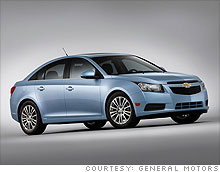NEW YORK (CNNMoney.com) -- Final rules for new fuel economy standards were unveiled by the government Thursday, placing the national average for all vehicles at more than 34 miles per gallon, well above current levels.
The new standards were originally announced in May 2009 by the Obama administration. The final details were unveiled jointly by the Department of Transportation and the Environmental Protection Administration.
 |
| New rules will inspire more cars like the recently unveiled Chevrolet Cruze ECO, which gets 40 mpg but without expensive hybrid technology. |
In general, the regulations require all passenger cars and light trucks sold in the United States to get an overall average of 34.1 miles per gallon by model year 2016. It's the first time there has been a national average for all vehicles.
By the 2016 model year, cars will be expected to average about 39 mpg while trucks are expected to get an average of 30 mpg.
Current fuel economy standards for new cars are 27.5 mpg for cars and 23.5 mpg for trucks. Currently, there is no requirement for a combined fuel economy average.
"These historic new standards set ambitious, but achievable, fuel economy requirements for the automotive industry that will also encourage new and emerging technologies," said Transportation Secretary Ray LaHood in a prepared statement.
Different automakers will have different fuel economy goals they will be required to meet based on the average size of the vehicles they sell.
Niche automakers, such as Germany's Porsche, will have their goals for cars being imported to the U.S. formulated under the same size-based guidelines, NHTSA officials said, with no allowance for horsepower or performance. But these manufacturers will be given a more gradual ramp-up time, while goals for other automakers will increase more rapidly, NHTSA officials said.
"It's a challenge, but it's a challenge we'll be ready to meet," Porsche spokesman Tony Fouladpour said.
The proposed plan is expected to cost automakers about $900 per car.
Consumers should be able to save enough in gas to make up for the extra cost. The EPA estimates that the new standards will save auto buyers about $3,000 over the ownership life of a new vehicle.
The EPA and the DOT's National Highway Traffic Safety Administration, which will jointly administer the rules, predicted that the changes will ultimately save 1.8 billion barrels of oil by 2016. That's roughly what the country goes through in about 86 days, according to numbers from the Energy Information Administration
Fuel economy will be increased gradually beginning with model year 2012 vehicles and continuing through model year 2016. The standards will apply only to newly purchased vehicles, not vehicles already on the road. These fuel economy requirements will be administered by NHTSA.
The new proposal represents a big shift in how the government regulates fuel economy. Fuel economy standards used to be considered solely as a way to reduce oil consumption.
But these new regulations are also aimed at reducing greenhouse gas emissions such as carbon dioxide, or CO2. The EPA will enforce new emissions rules which require vehicles, on average, to emit no more than 250 grams of carbon dioxide per mile.
The fuel economy goal of 34.1 mpg is lower than the 35.5 mpg goal that was originally proposed, but additional reductions in CO2 emissions will come from improvements in other areas such as the cars' air conditioning systems.
While other pollutants can be cleaned out of a car's exhaust by its catalytic converter, there is currently no way to remove CO2 from a car's exhaust. The only way to reduce CO2 in the exhaust is by reducing the amount of fuel that a car burns. This is why EPA and NHTSA were asked to work together to create the new standard.
For years environmental groups pressured both the EPA and the powerful California Air Resources Board to regulate greenhouse gas emissions from vehicles. ![]()






| Index | Last | Change | % Change |
|---|---|---|---|
| Dow | 32,627.97 | -234.33 | -0.71% |
| Nasdaq | 13,215.24 | 99.07 | 0.76% |
| S&P 500 | 3,913.10 | -2.36 | -0.06% |
| Treasuries | 1.73 | 0.00 | 0.12% |
| Company | Price | Change | % Change |
|---|---|---|---|
| Ford Motor Co | 8.29 | 0.05 | 0.61% |
| Advanced Micro Devic... | 54.59 | 0.70 | 1.30% |
| Cisco Systems Inc | 47.49 | -2.44 | -4.89% |
| General Electric Co | 13.00 | -0.16 | -1.22% |
| Kraft Heinz Co | 27.84 | -2.20 | -7.32% |
|
Bankrupt toy retailer tells bankruptcy court it is looking at possibly reviving the Toys 'R' Us and Babies 'R' Us brands. More |
Land O'Lakes CEO Beth Ford charts her career path, from her first job to becoming the first openly gay CEO at a Fortune 500 company in an interview with CNN's Boss Files. More |
Honda and General Motors are creating a new generation of fully autonomous vehicles. More |
In 1998, Ntsiki Biyela won a scholarship to study wine making. Now she's about to launch her own brand. More |
Whether you hedge inflation or look for a return that outpaces inflation, here's how to prepare. More |